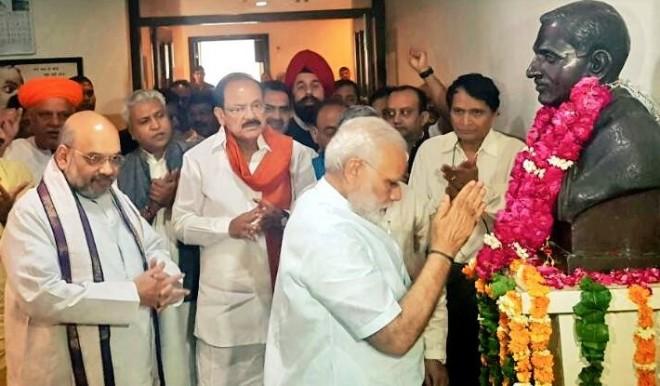
The Bharatiya Janata Party (BJP) on Thursday (April 6) celebrated its 38th foundation day with all-around tributes to its founder, former leaders and stalwarts, leading to colourful scenes at party headquarters across the country.
As BJP leaders greeted each other and party workers on this day, here's a look at the chequered history of the saffron party; how it came into being and what it has achieved so far. Here are 10 things to know about the history of the BJP:
1. The BJP's ideological mother organisation, the Rashtriya Swayamsevak Sangh (RSS) was founded by Dr KRB Hedgewar in 1925. However, it was not formally named the RSS until 1926. Interestingly, the RSS was banned after the assassination of Mahatma Gandhi, because of its alleged connections to Nathuram Godse. It would eventually be un-banned.
2. Dr Syama Prasad Mookerjee — son of Sir Ashutosh Mukherjee, who was also known as the "tiger of Bengal" — in 1951 formed the Bharatiya Jan Sangh (BJS), a precursor of to the BJP. The BJS would go on to form government in alliance with other parties at the Centre in 1977. The coalition would come to be known as the Janata Party.
3. The Janata Party faced a rout in the 1980 Lok Sabha elections, and the BJP emerged from its ruins. Former prime minister Atal Bihari Vajpayee was the founding president, ably assisted by his longtime colleague and former deputy prime minister LK Advani.
4. BJP leaders have been mired in a number of controversies, but the biggest of them was the 1992 Babri Mosque demolition in Ayodhya, Uttar Pradesh. The party was — and still is — big on the Hindutva agenda.
5. The party has a number of ignominies to its credit. For example, the BJP holds the record for the shortest tenure of a central government in the history of India: Vajpayee was at the helm when a coalition government formed by with the BJP as the biggest partner collapsed after a mere 13 day in 1996.
6. However, Vajpayee's subsequent rule was not entirely ignominious for the BJP. India conducted its second nuclear test under his regime in 1998. The Pokhran-II test well and truly heralded India on the world stage.
7. An ignominy the BJP has is that it was one of the first parties to fall prey to a sting operation: In 2001, then party president Bangaru Laxman was caught by Tehelka on hidden camera accepting bribes to rig a defence purchase. The incident brought the term "sting operation" into limelight.
8. And then came what was considered possibly the bloodiest period in the first decade of the 21st century in India. After 58 Hindu karsevaks were burnt alive in a train in Godhra in 2002, Gujarat burned for three days. Allegations were that the state administration, then headed by chief minister Narendra Modi, did not take proper action.
9. Since then, the BJP has bounced back in a big way. It managed to hand the Congress its worst Lok Sabha election defeat in the 2014 elections. While the BJP won 282 seats and its coalition won 336 in total, the Congress won only 44, while its UPA coalition won 60 in total.
10. Prime Minister Narendra Modi and the BJP will go down in history for enacting a monetary reform that took India by storm and the world by surprise. On November 8, 2016, Modi demonetised two currency notes of the biggest denomination, rendering a huge chunk of black money useless and cutting off cash funding for many illegal activities, including terrorism.










